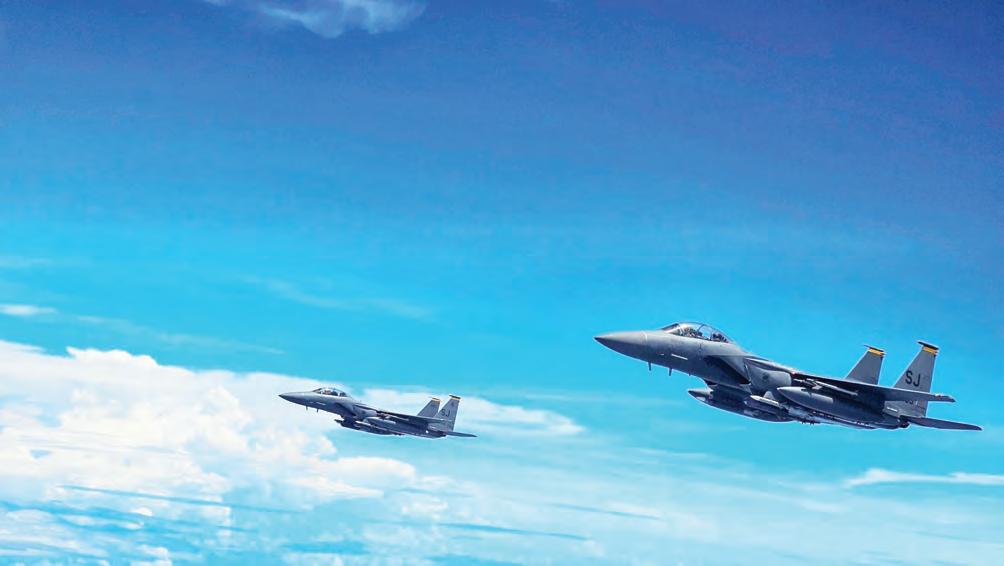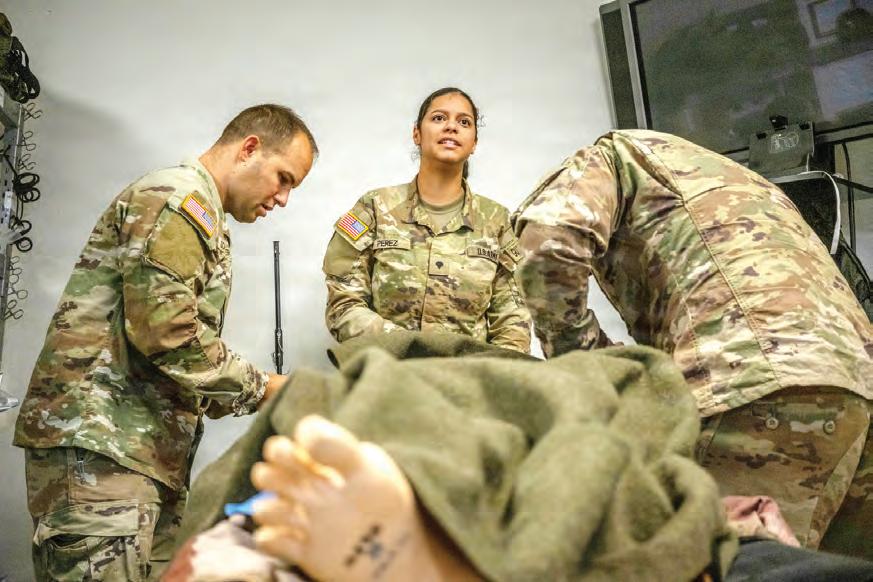

TRAVIS TAILWIND


THUNDER OVER BAY
The Air Force Thunderbirds perform
AMC modernizes connectivity to prepare for future mobility airlift
Staff Sgt. Dalton WilliamS AIR MOBILITY COMMAND PUBLIC AFFAIRS
ANDERSEN AIR FORCE BASE, Guam — From pioneering new data relay systems on the KC-46 Pegasus to prototyping agile communication platforms across the mobility fleet, Air Mobility Command (AMC) is taking bold steps to modernize connectivity and ensure decision advantage for the Joint Force.
During the U.S. Air Force’s 2025 Department-Level Exercise (DLE) series in July 2025, AMC Mission System Operators executed a successful test of the Taclane Augmented Roll-on Beyond Line-ofSight Enhancement System (TARS) onboard a KC-46. The demonstration marked a significant milestone in expanding the Pegasus’ role in command-and-control connectivity and advancing AMC’s contribution to the Joint Force’s Maneuver Battle Management System.
“This test was all about confirming the full path of data relay and validating that we can keep passing critical mission data,” said Staff Sgt. Michael Hagebusch, 22nd Operations Support Squadron mission system operator.
The test built on an initial trial conducted at Pease Air National Guard Base in May, which first proved the KC-46 could receive an IP-based Joint Range Extension Application Protocol connection to its tactical data link. By extending and securing connectivity, AMC crews now have greater capacity to sustain communication throughout contested environments –whether airborne or on the ground during refueling operations.
“This allows us to operate in ways that have never been available to us in the past,” said Master Sgt. Kyle Bone, AMC Mission System Operator Program manager. “Now, even

Staff Sgt. Dalton Williams/U.S. Air Force file Air Force Staff Sgt. Michael Hagebusch, a mission system operator assigned to the 22nd Operations Support Squadron at McConnell Air Force Base, Kansas, performs a demonstration of a Taclane Augmented ROBE System onboard a KC-46 Pegasus during the 2025 Department-Level Exercise at Andersen Air Force Base, Guam, July 24.
while aircraft are parked doing refueling operations, it’s operating as part of a tactical data link mesh network.”
A mesh network ensures resilient communication by automatically rerouting signals through alternate paths if one device goes offline. This redundancy is critical in austere or denied environments, allowing crews to maintain awareness and continue supporting the fight.
“TARS can collect and rebroadcast real-time information to overcome perceived area denial tactics like jamming,” Bone added. “It’s the next step in countering near-peer challenges.”
A startup approach to connectivity
At the same time TARS testing advances tanker connectivity, AMC’s
Commander’s Initiative Group is charting the future of mobility com munications through its Airlift/ Tanker Open Mission System (ATOMS) prototype program.
Formed after Operation Allies Refuge revealed gaps in command situational awareness, the group is a small, cross-functional team of pilots, engineers and software develop ers tasked with delivering decision advantage through rapid innovation.
“We’re the command’s little startup company – small, agile, and built to deliver decision advantage,” said Lt. Col. Paul Tucker, AMC CIG director and a C-17 Globemaster III pilot by trade. The ATOMS kit itself is built to be modular and flexible with network and server capabilities. Together,
McGhee Tyson ANGB selected to host KC-46A Pegasus MOB 7 in 2031
Secretary of the a ir force Public a ffairS ARLINGTON, Va. — The Department of the Air Force has selected McGhee Tyson Air National Guard Base in Knoxville, Tenn., as the preferred location to host the KC-46A Pegasus Main Operating Base (MOB) 7. A final basing decision for the location of the ANG’s KC-46A MOB 7 is expected in 2027. One base will be selected to host the new mission pending a final basing decision and the outcome of a planned environmental impact analysis anticipated no later than 2027. The first of eight aircraft are scheduled to arrive in 2031.
Eight KC-46As will replace all KC-135 Stratotankers at the final decision location and bring enhanced capabilities, such as boom and drogue defueling on the same sortie, worldwide navigation and communication, cargo capacity on the entire main deck floor, receiver air refueling, improved force protection, and multi-point air refueling capability.

Senior Airman Aidan Thompson/U.S. Air Force
Pegasus sits on the flight line at Joint Base McGuire-Dix-Lakehurst, N.J., Tuesday.
Holiday cheer starts here: Travis Exchange unwraps Black Friday, Cyber Week deals
clothing. (Dec. 1 – Dec. 4)
BASE — Travis AFB shoppers can score holly jolly savings as Army & Air Force Exchange Service stores open their doors worldwide at
8 a.m. on Nov. 28 for Black Friday sales.
Online deals for Black Friday at midnight central time at ShopMyExchange.com.
Shoppers can:
n Save up to $300 on Samsung TVs, including the Samsung 85-inch TV for $699 (regularly $999). (Nov. 28)
n Get Dyson Amber Silk Supersonic Nural hair dryer for $120 less than MSRP. (Nov. 28 – Nov. 30)
n Take an additional 50% off the regular price on 36-piece Godiva Goldmark chocolates. (Nov. 28)
n Take an additional 40% off Old Navy clothing for the family. (Nov. 28 – Nov. 30)
n Save up to 35% on all vacuums. (Nov. 28 – Nov. 30)
The savings continue during Cyber Monday and Cyber Week, starting at midnight central time.
Dec. 1. Deals include:
n Taking an additional 20% off: women’s Free People, Free People Movement and Liverpool clothing; men’s and women’s Kuhl and PBX Pro
n Saving up to $40 on JBL Noise Cxl Head Phones priced at $54.95 (regularly $95.95). (Dec. 1 – Dec. 4)
n Taking an additional 25% off the regular price on Ready Wise emergency 1-person 14-day bucket or 90-day organic bucket 90-serving. (Dec. 1 – Dec. 4)
“Supporting military families during the holidays means making their season brighter and their budgets go further,” Travis Exchange General Manager Cathie Byrns said. “These holiday deals in store and on ShopMyExchange.com ensure the Exchange continues to deliver real value when it matters most.”
Military shoppers can find a sneak peek of the Nov. 21 at Exchange’s “Weekly Ads” page at https://www.shop myexchange.com/cp/ static-pages/weekly-ads.
Military Star cardholders get exclusive Black Friday and Cyber Monday offers.
While most Exchanges will be closed on Thanksgiving Day, some service members will have access to convenience items on Thanksgiving Day, as nearly 120 Express locations will be open worldwide. Shoppers can contact their local PX or BX or check their Exchange’s social media pages for information.

Marines airlift relief to hurricane-hit Jamaica
M arine Corps staff sgt
Brett norM an and a ir forCe Capt.
K aylee sChanda
JOINT TASK FORCE BRAVO
KINGSTON, Jamaica — Joint Task Force Bravo, in concert with the 22nd Marine Expeditionary Unit, provided critical humanitarian assistance to Jamaica in the aftermath of Hurricane Melissa from Oct. 31 to Nov. 13.
As part of the U.S. military response, nine aircraft were allocated to support the effort, including three CH-47 Chinooks and three UH-60 Black Hawks from the 1st Battalion, 228th Aviation Regiment, JTF Bravo, and three CH-53E Super Stallions from the 22nd MEU, operating from the USS San Antonio.
In total, the team flew 249 hours across 133 flights, transporting more than 779,000 pounds of lifesaving assistance, including approximately 600,000 pounds of food and water, 179,000 pounds of equipment, and 428 critical personnel movements.
“JTF Bravo is designed and trained to rapidly respond when our nation or partners need us,” said Army Col. Robert Snyder, joint task force
AMC
From Page 1
these components effectively bring internet-like connectivity and computing power directly onto the aircraft. The system connects through multiple beyond-line-of-sight satellite communication providers, without being locked into a single vendor option. That flexibility ensures crews can maintain secure communication in contested or denied environments.

U.S. service members with
soldiers distribute food
commander. “What really stands out in a mission like this is the expertise and professionalism of our incredible service members – from the pilots and aircrew flying long hours to our troops on the ground managing logistics, airfield and flight operations, aircraft maintenance, and com-
and Joint All Domain C2.
This interoperability means mobility platforms are no longer simply enablers of others’ missions – they are nodes of information dominance, passing and receiving data that shapes decisions across the battlespace.
Building for the future
a
exChange serviCe
puBliC a ffairs
TRAVIS AIR FORCE
BASE — The Travis AFB Exchange is wrapping up its Salute to Service month with a final limited-edition giveaway – a collectible penny POG – for airmen, retirees and veterans with in-store shopping benefits.
This year marks the Army & Air Force Exchange Service’s first Salute to Service month, paying tribute to our nation’s heroes beyond Veterans Day. The penny POG giveaway is the final event of the special month.
POGs – cardboard currency – are a military tradition and now a collector’s item. Introduced as tools to allow troops
deployed to Southwest Asia in to pick up items of necessity and convenience while forgoing the expense of shipping heavy U.S. metal currency to contingency locations, the history of Exchange POGs go back nearly 25 years.
The newly released penny POGs were specially created for Exchange’s Salute to Service month, with service-specific artwork, including 32 updated designs honoring the distinguished service of airmen and the storied history of the United States Air Force. 2025 POGs will be given away on a firstcome, first-served basis beginning at 11 a.m. on Nov. 29 at the Travis BX.
“For many connected to the military, POGs are See POG, Page 4
ATOMS provides every crew position with secure tablets integrated with tactical data. It also enables a secure chat platform allowing crews to receive real-time mission updates, cargo changes and air refueling tasking without relying on vulnerable voice communications or other unencrypted systems.
“Instead of scrambling after landing, crews know changes before they hit the ground,” Tucker said.
From TARS mesh networking on the KC-46 to ATOMS prototyping across the fleet, AMC is pursuing multiple, complementary paths toward one objective: ensuring connectivity and decision advantage in tomorrow’s fight.
The lessons learned from DLE testing and global exercises are shaping formal requirements that will feed future modernization efforts that are resourced and scalable.
“We’re cautiously
and
munications to ensure we accomplish the mission. I am very proud of our soldiers, airmen, marines and sailors.”
JTF Bravo and 22nd MEU, in partnership with the Jamaica Defense Force and the U.S. State Department’s Disaster Assistance Response Team, were able to facil-
optimistic,” Tucker said. “Requirements are written, funding is in play, and competition is on the horizon.”
Whether through KC-46 advancements or
itate critical airlift of essential relief supplies to dozens of hurricaneaffected communities across Jamaica that were otherwise inaccessible.
“Watching our teams work side by side with the State Department, Jamaica Defense Force
CIG-driven prototypes, AMC is building the connected mobility force the Joint Force needs – resilient, adaptable, and ready to operate in contested battlespaces.



Beyond enhancing situational awareness, ATOMS is deliberately designed to be userfriendly. Its interface resembles a smartphone, displaying simple red or green indicators for system status, with one-touch access to key apps and a straightforward shutdown sequence. This simplicity reduces training demands and ensures that crews can focus on flying the mission instead of troubleshooting complex systems.
TRAVIS TAILWIND

By marrying modular hardware, flexible connectivity and intuitive design, ATOMS transforms mobility aircraft into data-sharing nodes for the Joint Force, ensuring decision advantage extends from the command level down to the tactical edge.
Integration across the Joint Force
Both ATOMS and TARS are designed to align with broader Air Force and Joint modernization initiatives and Joint modernization initiatives by connecting aircraft into key join force networks like the DAF Battle Network, Joint Fires Network,






Sgt. Nathan Mitchell/U.S. Marine Corps file
Joint Task Force-Bravo and Jamaican Defence Force
supplies
water in Niagra, Jamaica, Nov. 9.

F-15Es complete historic forward operations
Staff Sgt. Dwane R. Young
KADENA AIR BASE, Japan — F-15E Strike Eagles assigned to the 336th Expeditionary Fighter Squadron have rotated out of Kadena Air Base, Japan, concluding a six-month deployment that included a groundbreaking three-month forward operation to U.S. Navy Support Facility Diego Garcia.
While stationed at Kadena AB, the 336th EFS deployed a detachment to the remote Indian Ocean outpost to establish and operate Detachment 336 –marking the first sustained U.S. fighter presence on the island and a major milestone in the execution of Agile Combat Employment in the Indo-Pacific.
In response to an immediate request for forces from the U.S. Indo-Pacific Command, 160 airmen from Kadena AB, Yokota AB and Andersen Air Force Base deployed on May 13 to establish Detachment 336. Their mission is to project and sustain forward combat airpower from one of the most remote and strategically significant locations on Earth.
“This wasn’t just a TDY,” said Capt. Jimmy Boulton, 336th EFS F-15E pilot, “This was an operational ACE fighter detachment tailor-made for a rapidly developing, real-world mission. And we weren’t just flying jets; we were building a joint team locked in on our purpose.”
Over the course of the deployment, Detachment 336 achieved 24/7 alert operations, installed a mobile aircraft arresting system, and executed daily sorties, maintaining high mission-capable rates despite supply chains stretching halfway around the world.
“Our team had to

develop innovative solutions to meet maintenance requirements in a location without standard fighter infrastructure,” said Master Sgt. Jeremy McCoy, Det 336 maintainer, “So, we adapted quickly to keep jets and airmen ready and in the fight.”
In addition to flight operations, Detachment 336 assumed tactical command of joint defense forces, working alongside U.S. Navy Seventh Fleet, Marine Forces Pacific, and the 609th and 613th Air Operations Centers. Together, they executed air defense drills, base security scenarios and alert responses, establishing a fully integrated, layered defensive posture.
“We collaborated in real time with our Navy and Marine partners to develop joint solutions,” said Capt. Brianna Kretkowski, 336th EFS intelligence. “Each mission strengthened our battle rhythm and sharpened our readiness as a unified force.”
Life on the island also

demanded rapid, groundup innovation. Alongside Anderson Air Force Base’s 36th Mission Support Group, Detachment 1, airmen built and upgraded their tent city, nicknamed “Thundercove,” transforming it into a resilient base of operations.
From power distribution and sanitation to morale spaces and maintenance and operational headquarters, every improvement was built on-site, enhancing sustain-
ability and enabling high operational tempo.
“Every workaround and upgrade was about building momentum,” said Tech. Sgt. Cid Bartolome, Det 336 civil engineer. “It was about making the location viable not just for this mission, but for future ones as well.”
By the end of July, Detachment 336 had exceeded all mission objectives, demonstrating that a
From Page 2
and dozens of other organizations, it is clear to me that everyone shared the same goal: save lives and help the people of Jamaica,” Snyder said. “Throughout the operation, I have been extremely impressed with the professionalism and dedication of the Jamaica Defense Force, and I look forward to working with them again. I know we made a difference for the people of Jamaica, and we strengthened our partnership with the Jamaica Defense Force.”
To maximize the amount of time aircraft were able to operate on station, the task force established a forward arming and refueling point, accessible to JTF Bravo and 22nd MEU aircraft. This capability delivered nearly 25,000 gallons of fuel, which allowed aircraft to immediately refuel upon returning from missions, enabling a quicker return to follow-on missions.
Furthermore, the 22nd MEU facilitated safe operations of all aircraft through the employment of a Marine air traffic control mobile team, who oversaw arming and refueling operations, conducted surveys of helicopter landing zones, and established procedures for the safe loading of cargo onto aircraft.
“As a combat logistics battalion deployed with a Marine expeditionary unit that serves as a crisis response force, providing foreign humanitarian assistance is what we do, said Marine Corps Lt. Col. Zach Hornbaker, commanding officer of Combat Logistics Battalion 26, 22nd MEU. “I am incredibly proud of what we have been able to accomplish working alongside Joint Task Force Bravo and our partners in the Jamaica Defense Force.”
Hurricane Melissa made landfall Oct. 28 in Jamaica as a Category 5 storm with winds sustained at 185 mph.
Within 72 hours, U.S. service members from the task force were on location to reinforce the State Department-led response, assessing the
needs of the affected areas and coordinating logistic and airlift support to get emergency food, water, shelter materials and other relief supplies where they were needed most.
“The partnership between the Jamaica Defense Force and JTF Bravo, along with the 22nd MEU, is forged in a shared commitment to regional security,” said Jamaica Defense Force Lt. Col. Morton Stewart, bridge executive officer of the Maritime Air and Cyber Command. “This was proven by the immediate deployment to Jamaica following Hurricane Melissa, swiftly integrating into the JDF response mechanism to address Jamaica’s needs. This united effort showcases a resilience that not only thrives on interoperability, but also the incredible professionalism of the United States military, strengthening the very foundation of our bilateral cooperation to overcome any adversity.”
For more than 50 years, U.S. Southern Command has worked to build regional and interagency partnerships to ensure the continued stability of the Western Hemisphere.
During much of that time, JTF Bravo has supported U.S. military and humanitarian operations, providing critical airlift, medical, logistics, and security assistance to partner nations. JTF Bravo functions as Southcom’s rapid response element, enhancing regional security, promoting stability, and strengthening partnerships through disaster response, joint exercises and capacity-building.
The 22nd MEU is a forward-deployed, rapid response force with aviation, ground and logistics combat elements. For this mission, its combat logistics battalion was tasked to deliver foreign humanitarian assistance, alleviate suffering and help Jamaican communities recover from the devastating impact of the storm. The 22nd MEU came ashore to supplement JTF Bravo with additional logistical and aviation support, ensuring rapid, flexible assistance.

U.S. Air Force courtesy photos
F-15E Strike Eagles assigned to the 336th Expeditionary Fighter Squadron conduct a mission sortie during a three-month deployment to U.S. Navy Support Facility Diego Garcia, British Indian Ocean Territory.
RED HORSE airmen assigned to Det 336 install a Mobile Aircraft Arresting System amid intense environmental conditions during a deployment to U.S. Navy Support Facility Diego Garcia, British Indian Ocean Territory.
See F-15E, Page 7
Medics train for combat at Fort Campbell’s school of medicine
FORT CAMPBELL,
Ky. — In front of you is an off-white sheet metal warehouse. It sits along an unassuming road next to a mock village where verdant tree tops can just be seen capping each structure. Upon entering the building, you get a handful of classes, some things you already know, some you don’t, some you haven’t done in years. Soon, you enter a training lane, the cool air around you makes wearing your kit just a bit more bearable.
In the distance, you can hear artillery pounding the land paired with the rattling echoes of small arms fire. You move through the lane in blurred scenes until suddenly in front of you lies a mannequin simulating a wounded soldier.

of their life, so there’s a weight there. It’s not just on them, but psychologically on the medic too.”
It moves, bleeds, screams. You freeze for just a moment, barely able to hear the instructor directing you over the swell of your growing nerves.
You are a combat medic at the Alfred V. Rascon School of Combat Medicine, Fort Campbell, Kentucky, and this is a flashpoint. A brief second to overcome the anxiety, clear away the rust and engage in the muscle memory of your profession. Igniting this spark is the most important piece of the training because the instructors know the next flashpoint might not be in a breezy warehouse on a man-shaped piece of plastic.
“Tons of medics are super busy doing their jobs, which are really important, but we want them to remember ‘I’m a 68W. I’m an expert in trauma medicine,’” said Army Staff Sgt. Stevan Hargrave, the course coordinator at the Fort Campbell Medical Simulation Training Center. “So they come here, we put them out in the dirt with a bleeding casualty. Maybe you haven’t done it in a while, cool, you’re gonna figure it out.”
The MSTC team, mostly medics themselves, sees a major significance in the work they do.
“I feel like it’s passing on the torch to the younger medics,” said Hargrave with a pleasant but serious demeanor on his face. “We want them to be knowledgeable and have confidence because when you’re a medic, you’re the guy who’s helping someone on the worst day
Emphasizing the psychological aspect plays first chair in the team’s effort to cultivate a generation of skilled medics.
“When you have to treat your first casualty, that is the flashpoint,” Hargrave said. “There’s really no way to do it without actually doing it, but being able to train medics at this level means getting them as close as we possibly can before that happens.”
Ideally, when the care aspect becomes routine, it will be easier for a medic to overcome the one thing that cannot be replicated.
Their first casualty is likely to be someone they know, someone they are friends with, a person who has decided to entrust their life in that medic.
“When you’re a line medic at an infantry unit, there’s a lot of trust in you. You’re part of the team, and when something goes wrong, they look at you,” Hargrave said.
“You get there and you become doc,” he clicks his tongue and taps the table before correcting himself.
“If you’re good. You have to earn ‘doc.’”
Earning this title means demonstrating confidence in your abilities, taking part in the team, acknowledging the responsibility you hold and ultimately being accepted by the unit to whom you are accountable. For a lot of medics, this aspect comes naturally.
“It’s easy because you know everyone and everyone knows you,” said Army Sgt. 1st Class Aaron Villa, MSTC noncommissioned officer in charge. “They
treat you like one of them, and every time you prove yourself, then you make them feel safer, more at ease and more able to do their patrols day in and day out.”
Making a unit feel that sense of security is not a charge that can be filled through one-time acts or the attainment of knowledge in the past. Medics are required to have an unceasing drive toward improvement.
“Don’t be complacent,” said Villa, his eyes narrowed in calculation while his hands gestured with the rhythm of his speech. “Always try to better yourself, always try to learn more so that when you’re in that situation, you know what to do.”
“At the end of the day, you have the power to save someone’s life. You can’t be complacent about that.”
The work done by the MSTC team cannot be easily distilled into any one thing but ending complacency among medics stands as a pillar of their work. Creating a training regime focused on developing the medic corps for the next generation of warfighting also stays at the top of mind.
“With the way conflicts are changing, the things we need to train are obviously different,” Villa said. “That means training in different skills than we have before and making sure they’re ready to use them when the time comes. That’s how you earn that reputation and respect.”
Medics across the force feel this immense responsibility, which lends to a powerful feeling among those training at the Rascon School. All at once there is the enjoyment of doing what they






































love as well as the grim seriousness of doing what they must. Among these
Army Staff Sgt. Kaden D. Pitt/U.S. Army file
Army combat medic specialists assigned to the 101st Airborne Division perform simulated casualty care on a mannequin as part of training at the Alfred V. Rascon School of Combat Medicine at Fort Campbell, Ky., Oct. 31.
See Medics, Page 7
REFORPAC exercise underscores need for AI, autonomy, C2 and networks
Tribune ConTenT AgenCy
HONOLULU, Hawaii — Pacific Air Forces’s massive REFORPAC exercise in the Pacific this summer “identified the capabilities that we need to win in this theater,” the command’s deputy leader said last week: namely, artificial intelligence, autonomy, machine learning; improved command and control capabilities; and resilient cyber networks “that can communicate securely in expeditionary environments and survive relentless attacks.”

said, “from an operational perspective, the geography of this theater is incredibly challenging...so, our ability to command and control, to operate, to move with speed, scale, and agility across the vastness of this area is probably the most challenging thing that we do in not only the United States Air Force, but across all branches of the United States military.”
Speaking at the AFCEA TechNet Indo-Pacific conference, Lt. Gen. Laura Lenderman said that while “revisionist autocracies” want to “upend the security, freedom, and prosperity” of the IndoPacific, there is “another chapter we’re writing... filled with optimism and clarity, that strengthens deterrence, inspires progress and reinforces our shared vision of the future.”

That vision was “on full display” during Exercise Resolute Pacific, Len-
derman said. The exercise included 4,000 sorties at 50 locations that spanned 6,000 miles. Shortly after it kicked off
in July, Pacific Air Forces Commander Gen. Kevin Schneider said in an interview that this region “is critically important,
not only to the nations in the region that touch the Pacific Ocean, but to the world.” However, Schneider
Maj. Gen. Anthony Mastalir, who was then commander of U.S. Space Forces Indo-Pacific, noted in the same July interview that space capabilities are also critical in the theater. “If you’re going to project power, you have to have space. Space is the force multiplier that will allow us to project power great distances. So being able to close those gaps over the vast Pacific Ocean...in this theater, space superiority over the INDOPACOM AOR is a precondition for Joint



Union Avenue, Fairfield, CA www.1ag .com


























“The People of The United Methodist Church™”
Tech. Sgt. Nicholas Monteleone/U.S. Air Force file
A C-130J Super Hercules aircraft assigned to the 374th Air Expeditionary Wing rests on the flight line just before
the sun rises during Exercise Resolute Force Pacific 2025 at Yokota Air Base, Japan, July 21.
See C2, Page 6















Medics
From Page 4
competing moods, Villa and Hargrave stand in front of a whiteboard calendar planning the upcoming schedule.
One points out that the next major lane falls on Halloween, and from across the room, a team member, holding a paint-
ball gun, suggests they wear costumes. Everyone laughs, and just for a brief moment, there are no calculating eyes or serious faces, and it feels as though the light tone may win out. Yet, as quick as it came, it leaves, and the building returns to equilibrium. All present focused on giving the best chance to a soldier who will one day have a life in his or her hands.


19th CES undergoes Prime
F-15E
From Page 3
forward-deployed fighter force can operate, thrive and command from nontraditional bases, under exceptionally challenging logistical conditions.
“Our work is already shaping tactics, techniques and procedures across the theater,” Capt. Boulton said.
As the final Strike Eagles returned to their shelters at Kadena AB, the scope of the accomplishment came into full view. This was more than a deployment, it was a blueprint for flexible, air power-centric combat operations in the Indo-Pacific.

“In practice, operational ACE required Detachment 336 to define new organizations, invent new processes, and – at the individual airman and team level – aggressively move towards any and every risk to force or mission,” said Lt. Col. Mitchell Fossum, 336th EFS commander. “Our stewardship of the joint defense of Diego Garcia may soon be catalogued as merely another proof of the United States’ broad capability to rapidly deploy and reinforce deterrence with effective military power. To the airmen of Detachment 336, however, this mission and the defense of this exceptional, strategic island was a high calling and a privilege.”
LITTLE ROCK AIR FORCE BASE, Ark. — The 19th Civil Engineer Squadron conducted a Prime Base Engineer Emergency Force (BEEF) training event at Little Rock Air Force Base, Arkansas, Oct. 21-22, to sharpen skills under pressure.
The exercise aimed to prepare the squadron for deployments, global operations and humanitarian missions. The 19th CES plays a significant role in building and maintaining key elements of the base not only at Little Rock AFB, but also in foreign environments.
“Everything we do is to support all the infrastructure,” said U.S. Air Force
1st Lt. Brooke Mackay, 19th CES engineering flight commander. “This is how we prepare our young officers, as well as our NCOs to be ready for those unknown certainties with the rising climate.”
19th CES personnel set up and defended a simulated base, completing hands-on training designed to mirror real-world operations and reaffirm their commitment to rapid global response.
Airmen dug and filled sandbags to fortify the perimeter and constructed and maintained defensive positions using shovels, vehicles, air-soft training rifles and radios.
The exercise tested the squadron with simulated drone strikes and Other Country National (OCN) interactions. It











also featured scenarios that required quick, coordinated responses from Explosive Ordnance Disposal technicians.
“The airmen are tasked to set up the base, to defend their base and to make sure that the mission continues to operate,” McKay said. “Really it just allows them the opportunity to focus on some of those softer skills that they don’t typically do in their daily jobs.”
The Prime BEEF training wasn’t just about excelling under pressure, and U.S. Air Force Staff Sgt. Theodore Gould, 19th CES electrical power production craftsman, highlighted the exercise’s focus on reinforcing unit cohesion.
“We’re all working together,” Gould said.
“We’re training all day
together, and then we’re staying overnight together, so just like a deployment.” While the units participate in Prime BEEF training numerous times a year, alterations are made to ensure no two scenarios are ever the same.
“This is different; I’ve been here three years and I’ve never stayed [overnight] at Camp Warlord,” Gould said. “We’re exercising all day, getting hands on, and then going to sleep over in the tents. That’s a little unique about this training.”
Exercises like Prime BEEF ensure that Herk Nation remains ready to build, protect and sustain operations anywhere in the world – anytime the mission calls.







































Airman 1st Class Aidan Stein/U.S. Air Force file
Staff Sgt. Justin Bice, 19th Civil Engineer Squadron driver operator, defends the simulated base during a Prime Base
Emergency Engineer Force (BEEF) training scenario at Little Rock Air Force Base Arkansas, Oct. 21.
Army Staff Sgt. Kaden D. Pitt/U.S. Army file
Army Sgt. Kyle Patry, a combat medic specialist assigned to the 101st Airborne Division, performs casualty care on a mannequin as part of training at the Alfred V. Rascon School of Combat Medicine at Fort Campbell, Ky., Oct. 31.














